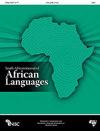同义词是西通加英译中意义消歧的语义框架
IF 0.2
0 LANGUAGE & LINGUISTICS
引用次数: 0
摘要
译者需要掌握措辞、词汇和语法,因为这些在不同语言之间有所不同。从英语翻译成Xitsonga通常是一项艰巨的任务,因为选择正确的单词可能很复杂。Xitsonga中的大多数词汇都有语义和内涵上的细微差别,这使得同义词的选择成为问题。本文探讨母语为L1的Xitsonga人如何在翻译成英语时准确地选择同义词。本文分析了翻译产品是如何组织起来的,以便对目标读者恰当而有意义地处理同义词。它采用了以词汇语义学理论为基础的定性研究方法,在描述性翻译研究领域有着更为广泛的地位。它的结论是,对同义词的掌握不能仅仅通过词汇表来实现,还需要译者对所处文化的了解。本文章由计算机程序翻译,如有差异,请以英文原文为准。
Synonymy as the semantic framework for disambiguation of meaning in the translation from English into Xitsonga
Translators are expected to master diction, lexicon and syntax, as these vary between languages. Translating from English into Xitsonga is often a daunting task, as choosing the right word can be complex. Most lexical items in Xitsonga carry semantic and connotational nuance, making the selection of one synonym over another problematic. This article explores how L1 Xitsonga speakers can select synonyms with precision during translation into English. The article analyses how a translation product is organised in a manner that deals with synonyms appropriately and meaningfully to its target readers. It employs a qualitative research method underpinned by the theory of lexical semantics, and is more broadly situated in the field of Descriptive Translation Studies. It concludes that mastery of synonymy cannot be attained through vocabulary lists alone, but also requires the translator’s knowledge of the cultures in play.
求助全文
通过发布文献求助,成功后即可免费获取论文全文。
去求助
来源期刊

South African Journal of African Languages
LANGUAGE & LINGUISTICS-
CiteScore
0.50
自引率
0.00%
发文量
30
期刊介绍:
The South African Journal of African Languages is a peer-reviewed research journal devoted to the advancement of African (Bantu) and Khoi-San languages and literatures. Papers, book reviews and polemic contributions of a scientific nature in any of the core areas of linguistics, both theoretical (e.g. syntax, phonology, semantics) and applied (e.g. sociolinguistic topics, language teaching, language policy), and literature, based on original research in the context of the African languages, are welcome. The journal is the official mouthpiece of the African Language Association of Southern Africa (ALASA), established in 1979.
 求助内容:
求助内容: 应助结果提醒方式:
应助结果提醒方式:


